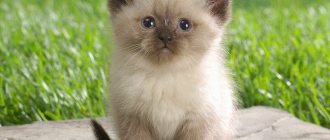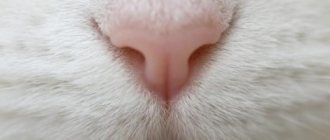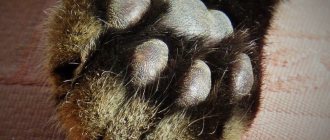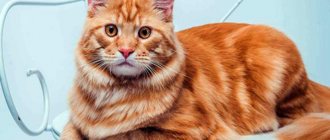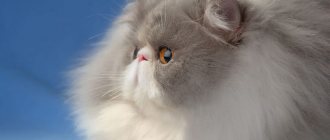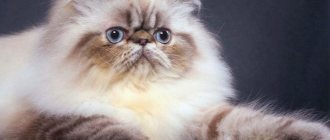Origin story
The history of the Persians - the aristocrats of the cat family - goes back to ancient times.
The very first images of furry babies were found in the ruins of Persepolis and Susa, which means that they lived in the courts of the first kings - Darius and Cambyses. In the 17th century, several individuals with amazingly long hair were taken from Isfahan (a city in Iran) to Italy by aristocratic traveler Pietro della Valle. Their traces were soon lost, and who knows how history would have turned out if Della Valle had not written about the amazing discovery to the French scientist Nicole-Claude Farby, a fanatical cat lover.
The latter, unable to contain his curiosity, personally went to Isfahan and took several luxurious Turkish Angora cats to France. The local aristocracy was conquered, including the notorious Cardinal Richelieu. Thanks to his patronage, long-haired cats became wildly popular: the local aristocracy began to race to have them in their own homes. Cats were called differently: French, Turkish, oriental.
Soon cats came to England and were so loved by the British that in 1887 the National Cat Club was organized in Great Britain and the first general standards were developed. Felinologists divided long-haired cats into 2 breeds: Turkish Angoras and French cats (gradually the name changed to Persian).
In the 20th century, Persians came to the United States and breeders rolled up their sleeves and began to work to improve their decorative features. The classic “British” version was changed and the so-called “extreme” type was born: with widely spaced eyes, an overhanging forehead, a short snub nose and deep folds near the eyes and mouth.
There is another opinion: long-haired cats supposedly appeared on the territory of Russia, as evidenced by their long, thick hair (without this they cannot survive in a harsh climate). And the animals were already taken from us to the East. But no even the slightest evidence of this has yet been found; this version bears little resemblance to the real one.
Standards
Based on appearance, the Persian cat is conventionally divided into 4 types:
- classic (nose located slightly below eye level);
- modern type (the edge of the nose intersects with the border of the lower eyelid, while the eyes have the shape of a circle);
- American (extreme) type: the nose is in line with the inner corners of the eyes, and seems to be concave inward;
- exotic (short-haired type): external characteristics correspond to general standards, the only difference is short hair.
| Standard | Description |
| Head | Large, dome-shaped, with a convex forehead. The cheeks are round and thick. The cheekbones are dense and powerful. The stop on the nose is clearly marked, the nose itself is wide and very short, most often snub-nosed (in individuals of the “Pekingese” type it is depressed). The muzzle is round and wide. The chin is weakly defined, the jaws are well developed. |
| Eyes | Large and round, widely spaced. The colors can be any, but, according to the standard, golden, silver and chinchilla cats should have only green shades, color-point cats should have blue shades, and Persians of any color should have orange and copper shades. |
| Ears | Small and neat, widely spaced, their tips rounded. The inner part is pubescent. |
| Neck | Short and powerful, with well-developed muscles. The body is the same: massive, with a wide back and strong bones. |
| Paws | Powerful, stocky, straight boned. The paw pads are round and elastic. Hair grows in tufts between the toes. |
| Tail | Short, outwardly proportional to the body, thick and covered with thick hair. Its tip is rounded. |
| Wool | Soft and shiny, can reach 12 cm in length on the body and up to 15 cm on the “collar”. Doesn't fit to the body. |
The disadvantages of the standard are: slanted and small eyes; a long tail; long legs and torso; long toes; oval paw shape; a long nose; large and close-set ears; narrow head.
Disqualifying signs: “medallion” on the chest; obvious jaw defects; knobby tail.
In the photo there are kittens of the Persian breed
Weight table
The weight of a Persian cat ranges from 3.5 to 7 kg. Females weigh slightly less than males. Weight table for Persian cats by month
| Age | Cat | Cat |
| newborn | 90-130 gr | 100-150 gr |
| 1 month | 390-460 gr | 410-530 gr |
| 2 months | 560-920 gr | 700-1100 gr |
| 3 months | 1-1.5 kg | 1.2-2 kg |
| 4 months | 1.4-2.3 kg | 1.7-3 kg |
| 5 months | 2-2.6 kg | 2.1-3.6 kg |
| 6 months | 2.2-3.4 kg | 2.6-4.4 kg |
| 8 months | 2.7-4.2 kg | 3.6-5 kg |
| 10 months | 3-4.5 kg | 4-5.9 kg |
| 1 year | 3.5-5 kg | 4.6-6.6 kg |
| 2 years | 3.8-5 kg | 5.2-7 kg |
Colors
In terms of the number of color types, the Persian cat will give odds to all other breeds, and all of them are officially recognized.
According to the exhibition rules, they are divided into 5 types:
- Single color;
- Smoky tabbies;
- Shaded;
- Partially painted;
- Point colors.
The photo shows a white Persian cat.
Common shades:
- The coat is black, the eyes are copper or orange. Impurities of a different color are not allowed, and patterns are not allowed. There may be a gray undercoat.
- Blue-eyed color-point with the obligatory cream shade of the body.
- Snow white with blue or orange eyes.
- Blue with yellow eyes.
- Fawn-cream color, copper color. Eyes the color of the fur. The presence of spots on the fur is not allowed.
- Red – rich, uniform orange with copper eyes.
- Bluish cream with copper eyes.
- Snow-white, apricot or smoky silver coat with brown or black tips. The eyes are green, outlined in black. The same subgroup includes lilac, blue and chocolate chinchillas.
- Persian Cameo (color can be yellow, cream or tortoiseshell) with copper-colored eyes.
- Smoky color, light silver undercoat. The eyes are orange.
- Two-color Persians, one of the colors must be white (no more than 50% of the total color). Copper eyes. A small number of colored spots are allowed.
- Tabby - silver, brown, red, chocolate, lilac, blue. Eyes copper, brown, emerald.
- Tortoiseshell color: a combination of spots of blue, chocolate, black, red and cream. Copper eyes. Mixing with white is allowed. The muzzle may have a red or cream tint.
- Pewter (pewter) - a mixture of white with shadows on the back and paws. The eyes are outlined in black and light orange.
- Pale lilac with a pink tint, copper eyes, outlined in black.
- Chocolate color of different shades, copper eyes.
- Marbled black with dark orange or copper eyes. The eyes are lined with black.
- Ivory color with bluish ticking, eyes lined, orange or copper.
- Black Spotted: The spots are oval or round, evenly distributed over the body, the eyes are outlined in black. Eye color is copper or dark orange.
- Black marbled with a silver body tint. The eyes are copper, outlined in black.
- Snow-white undercoat with a dark tint, green eyes of all shades, eyes outlined in dark.
In the photo there is a gray Persian cat
Persian cats breed description
Distinctive characteristics of the breed, recognizable features.
- A small snub nose, the shape of which in the extreme American type of breed looks small and strongly turned up. The European classic Persian has the usual slightly upturned nose.
- Fluffy, soft and silky long coat, reaching up to 15 cm with a variety of colors.
A complete description of the breed is provided in the summary table.
Table No. 1 Description of the Persian cat breed:
| Breed: Persian cat, origin: Iran (Persia), year of first registration: 1887 in Europe | ||
| External data | Description | Note |
| Body, body, chest. | The build is medium to large, stocky with a muscular, fairly broad chest. | Straight short bone looks squat but compact |
| Paws, limbs. | The legs are short, but muscular and powerful. The panties are clearly marked on the hind legs. A tuft of fur grows between the toes of the rounded paws. | Long hair hides the already short length of the limbs. |
| Tail. | Proportional length in comparison with the body, does not appear short due to long hair. | A sharp tail tip with knots along its length is considered a defect. considered to be a knobby tail |
| Head, muzzle, neck | On a thick, short neck, a large head with a wide forehead merges with the body. The muzzle has a round shape, on which a strong chin is clearly marked. | The neck is surrounded by a collar with a longer neck. A luxurious collar is a must. |
| Eyes, iris color. | Widely spaced, large, round eyes have a color that matches a specific coat. | For chinchillas – green; for color points - blue; for white, especially valuable ones - blue or multi-colored, one is light blue, and the second is orange. For all other colors, copper or orange tones are acceptable. |
| Ears | Set low above the forehead, the small, rounded ears are set wide apart. | There are tufts of fur inside the ears. |
| Wool | The long, up to 15 cm, thick coat is soft and silky to the touch. The thick undercoat lies close to the body. | Persian kittens can be solid, point or tabby in color. |
| Average height at withers in males and female cats | 28-30 cm | Due to long hair, the average height visually decreases, and weight, on the contrary, increases. |
| Average weight of Persians | from 3.5 to 7 kg | |
| Average life expectancy | Can range from 12 to 14 years, | With good care and health, the breed can live for up to 20 years. |
Persian cats and cats photos
Longhair
The body of the Persian cat of the classic and extreme type is covered with soft, silky hairs that hide a thick undercoat. The length of the fur in different parts of the body is distributed unevenly throughout the cat’s body and can range from 10-20 cm. A fluffy collar around the neck with a length of up to 20 cm. The panties on the hind legs and the tail have more enlarged hair.
Shorthair
The exotic shorthair cat is a half-Persian cat that is the result of the mating of an American shorthair cat and a Persian cat. As a result of selection, a new type of Persian was developed with a muzzle similar to a Pekingese, rounded, decorated with small ears and with a body covered with short hair.
Video
Types of Persian cats and their colors
Breeders from many countries have achieved that the Persian cat can have varieties with any coat color. The main classic types of Persian cat colors are still the most popular, these include:
- Solid, solid colors: white, blue, red, black, in which the coat is evenly colored without inclusions or spots of a different color.
- Bicolor colors, similar to the Siamese.
- The tortoiseshell color is characteristic mainly of females.
Black
The black Persian cat is covered with fine and silky fur without bleached spots or white speckles, especially long on the shoulders and around the neck. The American exclusive type Black Persian has the same charcoal paw pads, while the classic European type may have black or brown paw pads.
Blue
The longhaired Blue Persian is a very popular color all over the world. The fine, silky hair is evenly distributed over the dense undercoat, except for a longer collar on the neck. With a blue tint to the eyelids, a short flattened nose and gray-blue paw pads. Round, large eyes, orange or copper-tinged. Kittens are born with the presence of a tabby pattern, which gradually levels out to a blue color.
Tortoiseshell
A Persian tortoiseshell cat whose coat spots are evenly distributed over the body, and a red or cream tint is preferred on the face. There are several combinations of spots in color.
In the exclusive type of Persian, white predominates, especially on the belly, while in the classic type, white color and other tortoiseshell spots are evenly distributed.
Tortoiseshell males are born rarely and sterile.
White
The white Persian was the result of crossing with a white Angora cat, a very valuable color. A white cat with blue or multi-colored eyes is a beautiful animal, but often has a genetic disease; they have difficulty hearing or become completely deaf.
The fur should be pure white, silky evenly distributed over the body, and the snub nose should be pink, as should the paw pads.
Ginger
Persians with very long, silky hair of a thick red, pure red color are quite rare. They usually have brick-red colored paw pads, eye rims and nose. The eyes are round, large, orange or copper in color. The red tail is very fluffy.
Grey
The gray color of the Persian is solid solid with evenly colored hair from root to tip with the absence of white hairs and other marks. The color of the paw pads and nose mirror looks like the main color of the coat, and the large eyes are copper and less often green.
Color point
Color-point Persians have a cream or ivory-colored coat with non-blurred, clear spots, like Siamese. Large, round eyes of a dark blue color, almost blue.
Character and behavior
A Persian cat, like any other, once in a family, looks for a leader, a dominant, to whom it will obey for the rest of its life. Representatives of this breed themselves do not know how to be a leader, but they also do not want to remain at the bottom rung of the family hierarchy - they occupy the middle, where they feel quite comfortable. Accordingly, the Persians obey one person, and simply bestow their attention on the rest.
It is believed that males more often choose a woman as an owner, and cats - a man.
A smart and intelligent cat does not like fuss and is never in a hurry. This is a true phlegmatic: slow, thoughtful, with smooth movements - as they say, “on his own mind.” The little Persian doesn’t mind chasing a ball around the rooms, jumping on chairs and tables, playing tag, but as he gets older, he will prefer more interesting pastimes. As one well-known aphorism says, if you communicate with a kitten as with an adult, and with an adult as with a rational being, your Persian will not be inferior in intelligence even to a German shepherd.
Many Persian owners claim that the cat understands them literally. What they prefer most is communication with family members. If you talk to her often and affectionately, your kitty will understand that she is needed and loved. This breed is not suitable for fussy, active and active people.
Persians do not really like to sit on their hands, preferring to receive their portion of affection by sitting down at a distance. Inactive, meows rarely, loves to lie on the window for a long time and watch what is happening on the other side of the glass. But he is afraid to walk down the street. He communicates calmly with all pets: be it a dog, another cat, a parrot or a small rodent. Unfortunately, there are no Persian hunters.
They treat strangers with distrust. They are loyal to children, but do not tolerate being pulled by the tail. They value comfort and coziness: having chosen a cozy sofa or armchair for themselves, they will be extremely unhappy if someone else encroaches on it.
Mother cats are very caring and, curiously, show absolutely no aggression towards others who want to take a closer look at the babies or pick them up.
How did the cat move in K.I. Chukovsky’s famous poem “The Cockroach”?
jump backwards
Persians are vulnerable and touchy. You cannot raise your voice or raise your hand at them.
Expert opinion
Dusheba Vera Ivanovna
In 2010, she graduated from the Moscow State Academy of Veterinary Medicine named after K.I. Scriabin with honors, specializing in veterinary medicine. I regularly attend veterinary conferences, congresses, and webinars.
Persians are not carried by the withers, only with emphasis on the paws.
Care instructions
The Persian cat requires a lot of attention, as well as significant financial investments. You wouldn't want your luxurious pet to lose all its majestic appearance, would you?
Wool
Caring for a Persian's coat is a real sacred act. You will have to bring a lot of tools: a brush with natural bristles, a rare comb, scissors, and a spray for removing hair. But you don't need a powder brush.
If you do not train yourself to help your cat get rid of excess hair every day, your graceful cat will soon turn into a shapeless thing covered in tangles. And you can only get rid of them in a radical way - with the help of scissors. Therefore, brush your pet every 2 days: turn the pussy over on its back and brush the neck, belly, paws, then the back and head. Sprinkle the fur with grooming powder.
If you teach your Persian to do this while he is small, you will not have any problems with an adult cat.
Teeth and ears
Ear and dental care is standard. The ears should be cleaned every week with a cotton swab dipped in a special lotion, and the teeth should be cleaned thoroughly using a silicone brush and paste for cats (Levrana Love pets, Trixie).
Bathing
Bathing - once a month, during molting - 2 times. Choose a shampoo for long-haired cats: Perfect Coat, Protein-lanolin, Doctor. After bathing your pet in warm water and rinsing off the shampoo, dry the animal first with a towel and then with a hairdryer.
Be careful: Persians, despite their lush coat, catch colds easily. Protect them from drafts for 10-12 hours after the procedure.
Eyes
Clean your eyes daily. Moisten a piece of cotton or flannel fabric with special drops or warm chamomile decoction and clean the discharge from the tear duct. Do not use cotton wool, wet wipes or tap water!
Claws
Nails are trimmed every week using a special nail clipper.
Going to the toilet is a big event for your Persian. They sit there for a long time and also bury their waste for a long time. Buy a tray with high sides, and the filler is granular, not wood.
If you plan to attend exhibitions with your pet, home care will not be enough. You will have to use the services of a professional groomer.
Caring for Persian cats
Anyone who has a Persian cat will have to forget about laziness. You need to realize that your pet’s thick coat needs to be looked after daily and it’s not that easy. You need to bathe the animal once a month and constantly brush it. A cat should get used to these manipulations already in childhood, otherwise it will be difficult to cope with it later.
Bathing - once a month, the animal especially needs it during molting. Naturally, he may not particularly like this, but don’t frighten him or get angry with him - speak convincingly and calmly.
Before bathing, your pet's coat must be combed to remove tangles. Never wash your pet with human shampoo.
It is most convenient to wash the cat in a basin or in a baby bath.
The most important thing is to diligently rinse the wool after each soaping, otherwise after drying it will look simply terrible. Be careful not to get the detergent in your cat's eyes, ears, or mouth.
A special cat conditioner or antistatic spray will help improve the appearance of your Persian cat's fur. After completing the procedure, blot the fur with several towels.
Wet wool is combed in the direction of growth, drying the wool, also use a comb. The undercoat takes a very long time to dry, so it is strictly forbidden to let your Persian cat outside or leave it in a draft after the procedure.
To properly comb your Persian cat, the right tool is important. Forget about the slicker, because it is intended only for use by professional groomers when preparing a cat for a show.
Buy a metal comb with non-sharp teeth of fairly long length, ideally a double-sided tool with teeth of different frequencies. Brush your cat thoroughly, getting to the roots.
Divide the fur into zones, and then begin combing. The tangles are separated by the long teeth of the tool; if this is impossible, they will have to be cut off.
A Persian cat needs to be brushed daily, this is the only way to keep its fur beautiful and healthy. If care is regular, you will not spend more than ten minutes a day on it. A cat accustomed to manipulation will not break free, allowing itself to be scratched calmly.
The peculiarity of the structure of the muzzle can lead to problems with the eyes, because the tear ducts in Persian cats are blocked by the nose, which does not allow maintaining normal moisture in the eye.
Every day, your dog's eyes should be wiped with a napkin to remove any secretions. If you have recently noticed that your cat has discharge of an unusual color from her eyes lately, you should contact a specialist as soon as possible.
Make sure your animal's nose is clean. Persian cats are prone to runny noses, so the nose needs to be rubbed every day and cleaned when it gets clogged.
Persian cat ears are easy to care for. Once a week, treat your ears with a special product purchased from a veterinary pharmacy.
The next manipulation that any cat hates is cutting its claws. Try to do it at approximately the same time, so your pet will get used to it easier.
The claws are trimmed with a special tool; on the front paws they need to be trimmed once every two weeks, and on the hind paws - about once a month.
The best way to cut a Persian cat's hair is with a groomer, but a basic knowledge of this procedure won't hurt anyone.
There are two types of haircuts:
- hygienic. Performed before surgery or due to an animal’s illness;
- decorative At the request of the owner or during the hot season.
If a Persian cat has very shabby hair with many tangles, a haircut will be the best way to finally begin proper care.
As a rule, the animal is bathed before this procedure, but if it is only necessary to cut off the tangles, this need not be done.
Catering
Both experienced breeders and doctors say one thing: Persians should be fed in accordance with their health and age. From an early age, teach your cat to eat at a certain time.
Natural products
- Kittens feed on demand for up to a month;
- 1-2 months – eat 6 times a day;
- 2-4 months – 4-5 times a day;
- 4-6 months – 3 times;
- From 6 months – 2 times a day.
Daily food intake: 250 g per kilogram of live weight. For an adult cat – 300-350 g.
The first complementary food for a Persian baby is porridge cooked in diluted milk. From 3 months you can give frozen meat (naturally, before eating it is defrosted, doused with boiling water and minced). Serving – 0.4 teaspoon.
From 5 months, fermented milk products (natural yogurt, cottage cheese, low-fat sour cream, kefir, fermented baked milk), quail eggs, chicken yolk, and vegetables are introduced. You can also give children's cereal-vegetable mixtures.
Dry and wet food is allowed from 6 months. At first, the pads can be soaked in broth.
The diet of an adult cat should include:
- Meat (veal, rabbit, lamb, chicken, beef) – 50-60% of the total diet;
- By-products (chicken hearts and kidneys, raw cow stomach);
- Sea fish (salmon, hake, trout, cod) - no more than once a week;
- Vegetables (carrots, beets, green beans, pumpkin, cauliflower, zucchini) – every other day;
- Cheese (unsalted): once a week;
- Porridge (oatmeal, rice, buckwheat, millet, barley, for kittens up to 3 months - liquid semolina) - daily;
- Clean warm water: freely available (it is changed in the mornings and evenings).
Do not give to Persians:
- Milk
- Fatty meat (pork, goose),
- Smoked, salty, sweet, canned,
- Sauces, seasonings, spices,
- Baking,
- Bones and tripe
- Alcohol, carbonated and mineral water,
- Eggplants, potatoes, garlic, onions,
- Fat cottage cheese.
Recommended food
The best industrial food for Persians:
- German food based on poultry meat, vegetables and rice Bosch Sanabelle Hair.
- Italian Purina Pro Plan Delicate: food for sensitive digestion (40% protein, there is also a vitamin complex).
- Royal Canin Persian (Royal Canin, France): contains chicken, cereals and vegetables.
- Orijen Cat 6 Fresh Fish comes in the form of granules with a fishy smell that is pleasant to the cat. Contains a vitamin complex.
Expert opinion
Dusheba Vera Ivanovna
In 2010, she graduated from the Moscow State Academy of Veterinary Medicine named after K.I. Scriabin with honors, specializing in veterinary medicine. I regularly attend veterinary conferences, congresses, and webinars.
Industrial feeds are divided into 4 groups: economy, premium, premium and holistic. You should buy economy class food only as a last resort: they are poor in nutrients and protein, contain harmful dyes and additives, and can ruin your pet’s stomach in a short time. Premium food is somewhat richer in composition, but the amount of meat in them is minimal, there are preservatives that are harmful to health, and often cause allergies. Premium class and holistic are the most suitable options: they contain the required amount of protein and fiber, and add all the necessary vitamins and minerals.
Below are recommended super premium foods, links with food names are clickable. Using them, you can, within our website, read descriptions of food and read reviews from owners of the Persian cat breed.
| Premium | Premium | Holistic |
| Pro Plan | Royal Canin Persian | Golden Eagle |
Content Features
Naturally, Persian white kittens require careful care. Particular attention is paid to the eyes. This breed is a “crybaby” due to its physiological characteristics, so eye care begins when the pet is two months old. They are wiped with dry sterile gauze every day. If the discharge is abundant, then special drops will help the animal. Since kittens are furry, hairs can get into their eyes and cause irritation. The owner must promptly remove the foreign object and wash the pet's eyes.
White Persian cats require regular washing and brushing. The kitten is accustomed to water procedures from the very first day of its arrival in the house. Bathe your snow-white pet once every 14 days using special shampoos and conditioners. After the procedure, the “fluffy” is wrapped in a soft towel, and after a few minutes they begin to carefully comb the fur. It can be pre-coated with a softening spray, which will facilitate the process.
Brush your cat every day, as long hair can get tangled and there is a risk of tangles forming.
A Persian breeder's arsenal must include metal combs and voluminous brushes with hard bristles.
The nutrition of Persian kittens should be balanced and portioned. Pets treat themselves twice a day. Experts advise breeders to combine high-quality nutrition with homemade food. The Persian diet should contain a large amount of protein, which is found in meat, fish and eggs. In order for the pet’s coat to always be shiny and silky, the owner must add mineral and vitamin complexes to the food.
Dry food for Persian cats must be purchased in pet stores only from a trusted manufacturer.
For snow-white pets, a clean tray with natural filler that does not stick to the paws or stain them is important.
The features of this breed are discussed in the following video.
Several centuries ago, the Persians were the favorites of the European nobility. However, today, fluffy cute creatures have become popular all over the world. You can't help but fall in love with their character and appearance at first sight. Today I will tell you all about the furry immigrants from Persia - their habits, characteristics and rules for caring for Persian cats .
Diseases
Numerous experiments on appearance led to the fact that the Persians began to have serious health problems. The breeders had to backtrack a little, trying to eliminate the shortcomings, which required a lot of effort, time and money. However, modern representatives of the Persian breed cannot boast of good health.
- Polycystic kidney disease is diagnosed in 50% of Persians. If there is no treatment, by the age of 7-9 years the animal will develop kidney failure and die.
- The second most common disease is hypertrophic cardiomyopathy. Unfortunately, in half of the cases, symptoms do not appear until sudden death occurs. Cats get sick more often.
- Retinal atrophy occurs in kittens. The disease develops so quickly that by the age of 4 months the kitten becomes blind.
- Another weak point is teeth. In addition to regular cleanings, you need to take your cat to the veterinarian more often and, if necessary, clean his teeth using special devices.
- Changing your diet causes intestinal upset.
Health and illness
The Persian cat breed is characterized by fairly good health. However, there are some diseases that these purrs are most susceptible to. That is why, before adopting a kitten, it is important to check with the breeder all the features of its health.
Almost half of the felines of this breed are at risk for kidney disease (polycystic disease). The symptoms are as follows:
- sudden loss of appetite;
- worsening mood;
- frequent urge to urinate.
As soon as you notice at least one of these signs, it is advisable to contact your veterinarian. If treatment is not carried out in time, by the age of 10 the animal may show signs of kidney failure, which can be fatal.
In addition to polycystic disease, Persian cats can suffer from hypertrophic cardiomyopathy. It is difficult to track the disease, since symptoms appear already in an advanced stage, when treatment is useless. According to statistics, males are more susceptible to cardiomyopathy.
Pay close attention to your animal's teeth and eyes. Persians are prone to gingivitis (gum disease) as well as early tooth loss. From a young age, a cat can develop retinal atrophy, which quickly leads to blindness. To avoid this, perform regular eye hygiene.
Due to the special structure of the head, all kittens of this breed experience increased tear production. The shape of the muzzle also affects the structure of the nose. Because of its characteristics, Persians snore or even snore in their sleep.
Since Persian kittens are long-haired, it is necessary to regularly give them products that remove hair from the stomach.
With proper care and regular visits to the veterinarian, Persian cats can live between 15 and 20 years.
